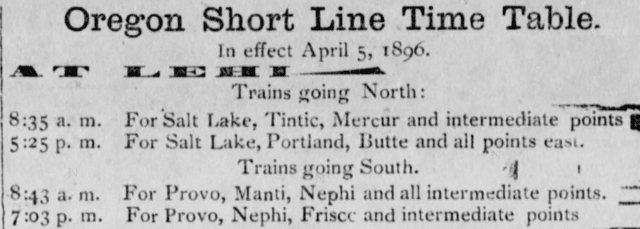
Personal Histories
The book Our Roots Grow Deep: a History of Cedar Valley, by Margery J. Peterson, has a section on the railroad in the Cedar Valley.The coming of the train to Cedar Valley, brought with it other types of employment. In the ward report, Brother George Thurman wrote on June 11, 1868, “There is some little stir in regard to the railroad. Some are making arrangements to go to work immediately on the road”. The old railroad grade can still be seen east and south of town as it winds its way through the fields. The Utah Southern Railroad was the first train to arrive in Lehi, which occurred on September 23, 1872. Soon the Union Pacific railroads first mainline from Salt Lake City to Los Angeles went through Cedar Valley in the 1880’s. It had a spur that went up to Mercur called the Salt Lake Mercur Railroad. After many of the mines closed the train was rerouted through Rush Valley. The grade up Five Mile Canyon was too steep for trains on their regular main, however service was maintained to the clay mines by another spur up this canyon until 1952 when it was entirely abandoned.There were several Lima Shay engines that ran the route from Fairfield to Mercur that were owned by the Salt Lake & Mercur Railway. The shop number is the serial number for the engine, not the number that was displayed on the locomotive assigned by the Railway. Photos from http://www.shaylocomotives.com Locomotive #2 – Built in 1895 (Shop Number 489)One can see many railroad ties around Cedar Fort and in the fields. Farmers found them to be very useful in building sheds and granaries. They made excellent comer posts for fences and gates, and sometimes were used as firewood. John Henry Ault, grandfather to several generations of Ault’s in Cedar Fort was an engineer on the railroad for 19 years. He operated the Shay Engine that pulled the train up the 6% grade into Mercur from the Fairfield Switch to Manning. Vinnie Ault, his daughter-in-law says of this experience, “Over the years, driving the train became a force for good in his life. He respected the huge, powerful engine, which never refused to go anywhere or do anything he wished, with power left in reserve. No hill was too steep or day too long. It seemed as though it could climb right up into heaven if he wished it to. The screeching wheels gliding over the shiny rails made his blood race at the ease with which they fulfilled their mission. The shrill whistle made his heart beat ecstatically with pride. He was the master of the great engine. His children were influenced because of the pride and love their father felt for this powerful piece of equipment. Many diligent technicians had labored to build it, but even greater than that, God, the master of all, had created the raw material and intelligence for man.” [Our Roots Grow Deep 7-9]
 Locomotive #3 – Built 1896 (Shop Number 513)
Locomotive #3 – Built 1896 (Shop Number 513)
 Locomotive #5 – Built 1898 (Shop Number 563)
Locomotive #5 – Built 1898 (Shop Number 563)
 Locomotive #7 – Built 1900 (Shop Number 598)
Locomotive #7 – Built 1900 (Shop Number 598)
 Locomotive #9 – Built 1906 (Shop Number 1787)
Locomotive #9 – Built 1906 (Shop Number 1787)
 Vinnie Ault had this to say about the experience his Grandfather J. H. Ault, “Grandfather Ault had many interesting experiences as the engineer on the Salt Lake and Mercur Railroad. He saw the beauty of nature on every side, the majestic mountains capped with snow by winter and dressed in their greenest finery by summer and interspersed with deep winding valleys and sparkling streams.” [Our Roots Grow Deep 12-5]
The railroad was used to transport sheep during the spring Fairfield sheep sheering. “In the spring of the year, Fairfield would seem to turn into a dust bowl, as 100,000 sheep were herded into shearing corrals. They were herded to this central corral to be sheared each spring. A railroad spur provided transportation of the wool to market. Now the sheep are trucked from place to place, and are often sheared near their pastures by migrant shearers. The old timers used to say a very good shearer could shear 100 sheep a day.” [Our Roots Grow Deep 9-11]
Vinnie Ault had this to say about the experience his Grandfather J. H. Ault, “Grandfather Ault had many interesting experiences as the engineer on the Salt Lake and Mercur Railroad. He saw the beauty of nature on every side, the majestic mountains capped with snow by winter and dressed in their greenest finery by summer and interspersed with deep winding valleys and sparkling streams.” [Our Roots Grow Deep 12-5]
The railroad was used to transport sheep during the spring Fairfield sheep sheering. “In the spring of the year, Fairfield would seem to turn into a dust bowl, as 100,000 sheep were herded into shearing corrals. They were herded to this central corral to be sheared each spring. A railroad spur provided transportation of the wool to market. Now the sheep are trucked from place to place, and are often sheared near their pastures by migrant shearers. The old timers used to say a very good shearer could shear 100 sheep a day.” [Our Roots Grow Deep 9-11]
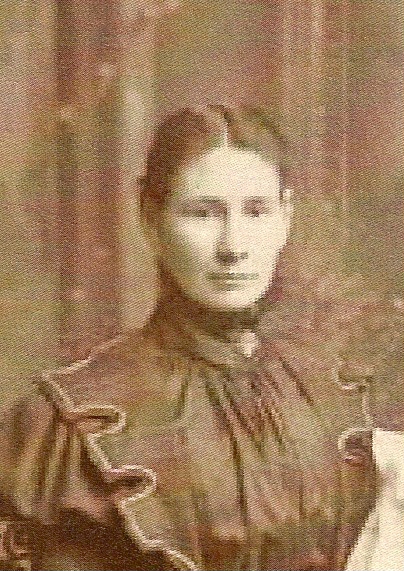
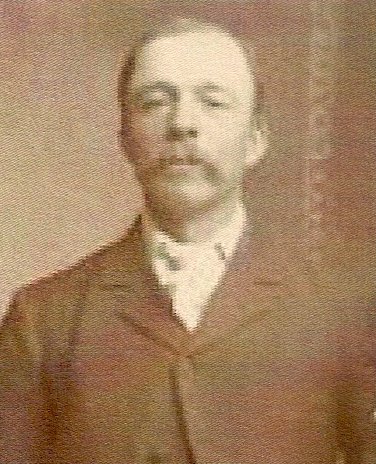 The railroad in Cedar Valley was also reason Otto Alfred Anderson from Sweden was in the United States looking for the “wonderful opportunities” America provided. While he was working on the railroad in Cedar Valley, he meet Eleanor Hacking who was a resident of Cedar Fort. The two of them were later married on April 17, 1885. [Our Roots Grow Deep 96]
John Melvin Anderson, a resident of Cedar Fort Utah said this about the Railroad in Cedar Valley, “I began at the age of 12 assisting my father with water service for the Union Pacific railroad. At a time when the train ran from Lehi to Cedar Fort. And at the age of 15 I started to work for the O.S.L.R.R. (Oregon Short Line Railroad) on 3 January 1899 as a pumper, at Lehi and Cedar Fort. Wages were $29 a month. On monthly pay days, they ran a armored pay car, and I was paid a $20 gold piece and a $5 gold piece and 4-1/2 silver dollars. There isn’t any one to verify this now that I know of. At Cedar Fort, we had a brick dug well 98 feet deep. The Knowles steam pump was down the well 90 feet. My boiler was a Locomotive fire box boiler. I complained of the scoop shovel being so big. It was a no. 5 scoop. I could not lift it to the fire box door which was about 4 feet, so they gave me a track shovel and 1 made it after that. “[Our Roots Grow Deep 97]
Below is a picture of one of the engines used the the O.S.L.R.R. on its lines, this locomotive may at one time ran the rail lines in Cedar Valley.
The railroad in Cedar Valley was also reason Otto Alfred Anderson from Sweden was in the United States looking for the “wonderful opportunities” America provided. While he was working on the railroad in Cedar Valley, he meet Eleanor Hacking who was a resident of Cedar Fort. The two of them were later married on April 17, 1885. [Our Roots Grow Deep 96]
John Melvin Anderson, a resident of Cedar Fort Utah said this about the Railroad in Cedar Valley, “I began at the age of 12 assisting my father with water service for the Union Pacific railroad. At a time when the train ran from Lehi to Cedar Fort. And at the age of 15 I started to work for the O.S.L.R.R. (Oregon Short Line Railroad) on 3 January 1899 as a pumper, at Lehi and Cedar Fort. Wages were $29 a month. On monthly pay days, they ran a armored pay car, and I was paid a $20 gold piece and a $5 gold piece and 4-1/2 silver dollars. There isn’t any one to verify this now that I know of. At Cedar Fort, we had a brick dug well 98 feet deep. The Knowles steam pump was down the well 90 feet. My boiler was a Locomotive fire box boiler. I complained of the scoop shovel being so big. It was a no. 5 scoop. I could not lift it to the fire box door which was about 4 feet, so they gave me a track shovel and 1 made it after that. “[Our Roots Grow Deep 97]
Below is a picture of one of the engines used the the O.S.L.R.R. on its lines, this locomotive may at one time ran the rail lines in Cedar Valley.

Line Abandonment
In January of 1912 they had to reduce the number of trains that ran that line. “.. changes are necessary on account reduction of service and decreased business.” (Letter from Salt Lake and Mercur Railroad Company dated January 17th, 1912.) J. H. Ault on November 1, 1913 was released from his job as an engineer due to the closing down of the Salt Lake and Mercur Railroad Company.[Our Roots Grow Deep 10-10] The Magazine “The Streamliner” that is published by the Union Pacific Historical Society had an article on the Tintic Subdivision in its Summer 2005 issue. In that article, they discuss the Abandonment of the line. “With completion of the Leamington Cutoff in 1903, this old piece of the original Salt Lake & Western had been renamed the Fairfield branch, and after the cutback in 1921, the Fairfield branch lost its through-connection to the mainline. At the same time, in 1921, a daily passenger train between Salt Lake City and Tintic, by way of the Fairfield Branch was also cut off.” The article continues, “The branch itself, what remained of the original Salt Lake & Western, was finally abandoned between Cutler and Five Mile Pass in 1942.” Cutler or Lehi Junction is the name of the station that was located in Lehi at the time.Accidents on the lines
As with any railroad, there were accidents along the line as well. With the advancement of civilization there is always the risk of injury and the railroad in Cedar Valley was no exception to this. It had it share of deaths and accidents while it had trains running its lines.Death on the line
The Lehi Banner reported that in Sept 1905 a man was killed while helping the train pass under some power lines near Fairfield. “Last Saturday the foreman of the bridge gang who are working near Fairfield was fatally hurt. It seems that the pile driver was so high that when they came to where the Teliuride Power Co. cross the track, the wire had to be raised in order to let train by. The foreman went to the top of the derrick to raise the wire with a broom but the current was so strong it burnt the broom and his clothes caught fire and he fell several feet. He was sent to the hospital at Salt Lake, where he died from effect of electrical shock and fall.”Narrow Escape
Also in Sept 1905 The Lehi Banner reported about a passenger car on the Fairfield branch, “about a mile this side of the Fairfield switch” rolled. The track was damaged by the car ahead of the passenger car that was carrying about 100,000 lbs of lime rock. The car contained 13 people at the time. When the passenger car hit the damaged track it derailed. “As the car rolled down the embankment, the occupants, the stove filled with fire, lamps, and other loose furniture, were all throw about in the car.” The article continues, “All were hurt more or less, either cuts or bruises. Some had bad cuts which took four to eight stitches to repair. Mr.s Zimmerman was, however the greatest sufferer, as she had her shoulder dislocated. The babe was found under a car seat uninjured.” But the doctor, Dr. Stookey, said that “none of the injuries will prove serious.”Picking up the bones
It is mentioned in “Our roods Grow Deep” that Mamie Ault Claton of Cedar Fort would play along the track line outside of Cedar Fort. They were living at the “railroad station which was two miles east of Cedar Fort.” In her account is states, “While Mamie lived at the station, she helped pick up the bones of a man named Eddie Jones. He had been hit by a train. Mr. Jones was from Lehi.” The Eddie Jones that Mamie mentions is Edward Henry Jones from St. Leonard England, but was living in Lehi at the time of the accident. He was the father of four daughters, two of which were born in Lehi and was 31 at the time of the accident. He was “Killed accidentally on the SL&W RR” on April 6, 1890, according to the Utah Death Register. The Utah Enquirer on April 8, 1890 reported that Edward Jones, “a fireman on the Salt Lake and Western division of the Union Pacific Railroad” was “thrown down on the tracks between two cars” after a coupling broke while he was on the water tank signaling the engineer.Other Resources
Utahrails.net ShayLocomotives.com Union Pacific Historical SocietySupporting Materials
[wpfilebase tag=”file” id=3851 /] [wpfilebase tag=”file” id=3852 /] [wpfilebase tag=”file” id=3853 /]Mike Kieffer is an IT geek by hobby and trade, with a BS in Information Systems & Technology. He is a proud father of 10, a grandpa, an author, a journalist, and internet publisher. His motto is to “Elevate, Inspire and Inform”, and he is politically conservative and a Christian. Mike has a passion for technology, writing, and helping others. With a wealth of experience, he is committed to sharing his knowledge with others to help them reach their full potential. He is known for his jackassery or his form of self-expression that encourages boldness, creativity, and risk-taking. It can be a way to push the boundaries and challenge traditional norms, leading to creative solutions and positive change.
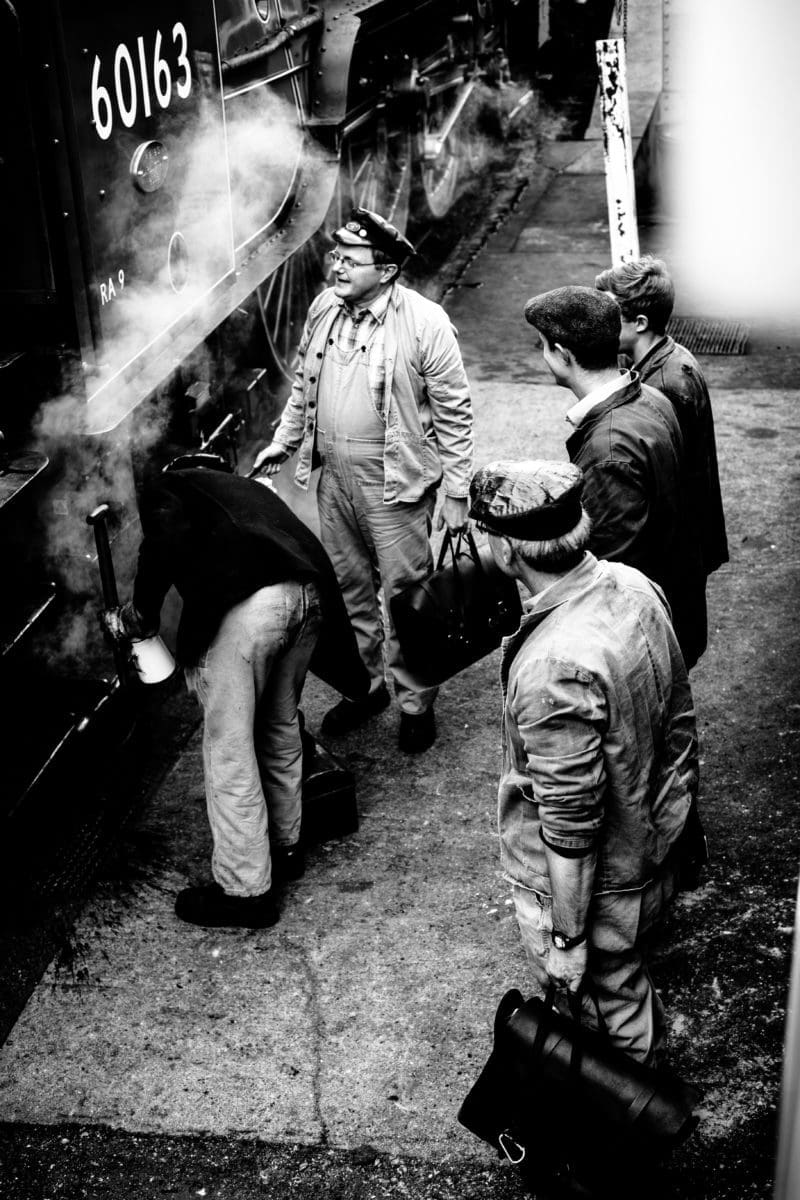
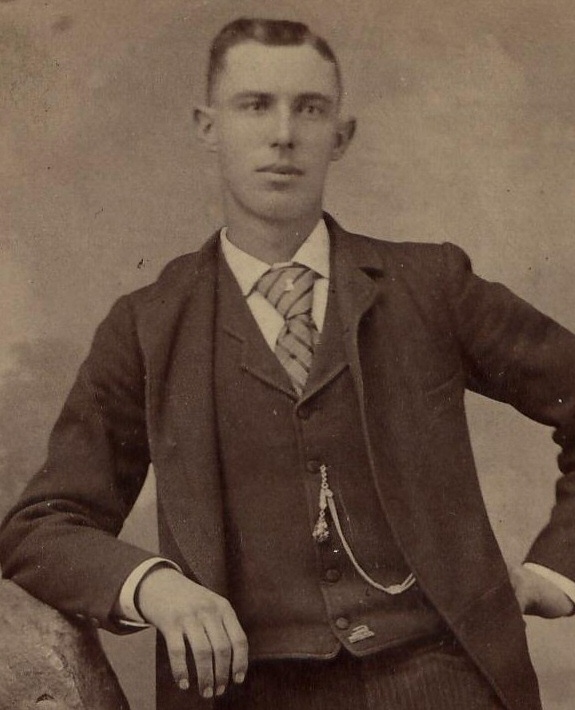
Very cool
A nice informative article on some of the history of our community. I enjoyed it very much. thanks.
Mike, thank you for looking into the history of Eagle Mountain! You have taken some of the things I have found out about our city to the next level for sure! I appreciate it more than you know! –Paul Jerome